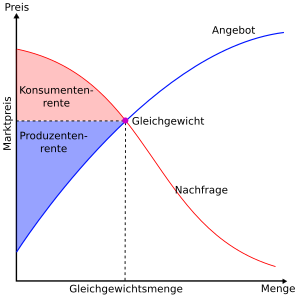Producer surplus
The producer surplus (Engl. Producer surplus ) is by Alfred Marshall , the difference from the equilibrium price that the producer due to the market conditions actually receives (market price) and the price he at least needs to stay profitable (1890) ( reservation price ). The producer rent is an economic rent that is opposed to the consumer rent . Together these are the essential building blocks for determining economic welfare .
Producer surplus and profit
The producer surplus is closely related to profit , but not to be equated with it. Distinction:
- PR results from the difference between revenue and variable costs
- Profit is the difference between revenue and total costs (both variable and fixed costs ).
The definition of producer surplus is not clear in the literature. Hal Varian describes producer surplus as "Revenue minus variable costs, or equivalent, profit plus fixed costs." (Varian, 1999, p. 362). Jean Tirole, on the other hand, writes: “The company's profit is also referred to as producer surplus. The profit is equal to the proceeds minus the costs. ”(Tirole, 1999, p. 17). Even Wolfgang Cezanne (1997, p 155f) meant by the producer surplus profits: "If market prices over the total average costs so a gain arises. This profit is known as producer surplus [...] ”.
Since there are no fixed costs in the long term, in this case one can speak of a producer surplus as the difference between sales and variable costs.
Explanation
In contrast to the psychological size of the consumer surplus, the producer surplus depends on the cost structure of the respective company. Not all companies work equally efficiently. The market price corresponds exactly to the production costs of the supplier who can just barely stay on the market ( marginal supplier ). All companies that produce more cheaply than the marginal supplier generate extra profits. Although the marginal supplier operates in the market, he does not receive any producer surplus.
The term producer rent is also misleading because the extra profits do not constitute economic rent in common parlance. Rather, they are the reward for the fact that the companies concerned produce more cheaply than the frontier supplier .
example
A special MP3 player is bought and sold at a price of € 100 (market price), but supplier A could have offered it for € 80 (due to its lower production costs). He “saved” € 20 compared to the general sales price (producer's pension).
meaning
The producer surplus is interesting under conditions of restricted competition :
- With perfect price discrimination , the provider receives the sum of producer and consumer surplus and thus, as in the case of competition, reaches the welfare maximum. In order to be able to make a statement about his profit situation, however, knowledge of the cost structure is necessary.
- In a monopoly , the monopoly succeeds in increasing the producer surplus in a profit-maximizing way by either fixing the prices or the quantities. However, there is a tendency towards an undersupply of monopoly goods when there is an oversupply of goods that are offered under competitive conditions, so that overall welfare falls.
Individual evidence
- ↑ Ulrich van Suntum: The invisible hand . Jumper; 2005, 3rd edition, page 26.
- ↑ Pindyck, Robert S. microeconomics. Pearson Deutschland GmbH, 2009. p. 384.
- ↑ Producer's rent - definition in the Gabler Wirtschaftslexikon.
- ↑ Ulrich van Suntum: The invisible hand . Jumper; 2005, 3rd edition, pages 26/27.
Web links
- Consumer and producer surplus (graphic) (PDF file; 14 kB)
- Producer surplus - definition in the Gabler Wirtschaftslexikon
- Producer's pension - detailed article at mikrooekonomie.de

